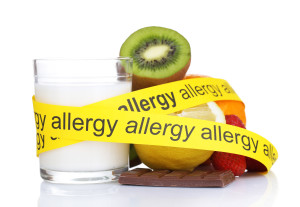 People who have allergies react to normally harmless substances. These substances are called allergens. Another term for allergy is atopy. Allergic conditions include allergic rhinitis, non-allergic rhinitis, allergic dermatitis, asthma, and uticaria. The most common allergic condition is allergic rhinitis. This is applied to anyone who has allergy based symptoms.
People who have allergies react to normally harmless substances. These substances are called allergens. Another term for allergy is atopy. Allergic conditions include allergic rhinitis, non-allergic rhinitis, allergic dermatitis, asthma, and uticaria. The most common allergic condition is allergic rhinitis. This is applied to anyone who has allergy based symptoms.
Signs of allergies include a clogged or runny nose. You may experience itching in your eyes, throat or nose. Your eyes may water or swell. Allergic eyes can develop red rims or crusting. This is because the membranes under your eyelids are swollen. You can often spot a person with allergies because of the dark circles under their eyes. These so called allergic shiners are due to increased blood flow around the sinuses.
Contact dermatitis, uticaria and eczema show up as red, swollen or itchy skin. You may also experience welts or hives on your skin. many common substances can cause skin reactions such as certain plants, metals, chemicals, cosmetics and medications. Hives (urticaria) are caused by food allergies. Triggers can include nuts, berries, shellfish, eggs or tomatoes.
 Some times allergies can lead to asthma. Symptoms of asthma include a feeling of breathlessness or tightness in the chest. You may cough, wheeze or have difficulty inhaling or exhaling. Asthma attacks can be serious, or even life threatening, and require medical attention.
Some times allergies can lead to asthma. Symptoms of asthma include a feeling of breathlessness or tightness in the chest. You may cough, wheeze or have difficulty inhaling or exhaling. Asthma attacks can be serious, or even life threatening, and require medical attention.
Many people suffer from mild allergies which include hayfever. This is a seasonal affliction that can cause itchy and watery eyes. It can lead to a stuffed nose, postnasal drip, sneezing or congestion. People with this condition are usually sensitive to things like trees, grasses, weeds or mold spores. Perennial allergic rhinitis is a year round concern. People who suffer from this usually react to things like house dust, mold, specific foods, animal dander, proteins or saliva. Perfumes, chemicals, air pollutants and tobacco smoke can also trigger symptoms.
Some people experience a severe reaction called anaphylactic shock. Foods, insect stings or medication can lead to this life threatening reaction. Anaphylactic shock may trigger sudden swelling which can cut off your air supply. Symptoms include weakness, pale skin, confusion and breathlessness. You may become unconscious. You need immediate medical attention.
 There are generally three ways to treat allergies. Avoidance is often your first move. You need to pinpoint the substances that trigger your allergic reaction. You can often do this with allergy testing. Allergy testing involves injecting a small amount of an extract of a suspected allergen into the skin. When your skins swells into a hive, you are allergic to that specific allergen.
There are generally three ways to treat allergies. Avoidance is often your first move. You need to pinpoint the substances that trigger your allergic reaction. You can often do this with allergy testing. Allergy testing involves injecting a small amount of an extract of a suspected allergen into the skin. When your skins swells into a hive, you are allergic to that specific allergen.
People with pollen, dust and mold allergies may need to practice avoidance of the things that set them off. If you have hay fever during a certain season, you should close all windows and doors. You may want to stay indoors during morning hours when pollen counts are high. Windy days can also stir up allergens. Try to use an air conditioner to filter the air in your home and car. Air filters and dehumidifiers are also a good idea. Feathers and wool are often sources of allergens. In some cases, people will have to get rid of carpets or upholstered furniture. House plants can be a source of mold and pollen. You can buy plastic mattress covers and pillowcases to lock in allergens. Its a good idea to wash your bedding in very hot water once a week.
There are various medications on the market to control allergy symptoms. Talk to your doctor or pharmacist about which drug is best for you. You can also undergo immunotherapy. This involves weekly injections of increasingly strong allergen extracts to help desensitize your body to those substances.
